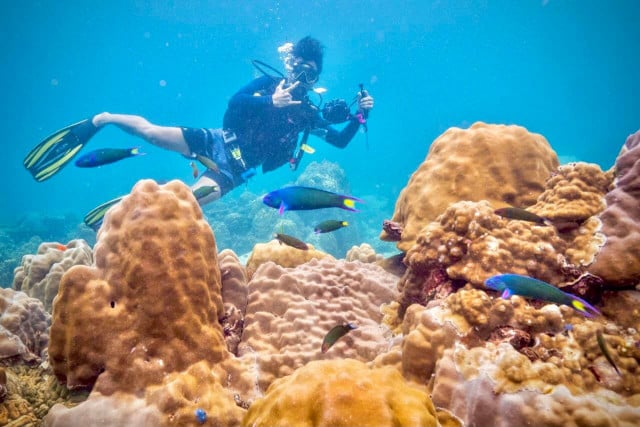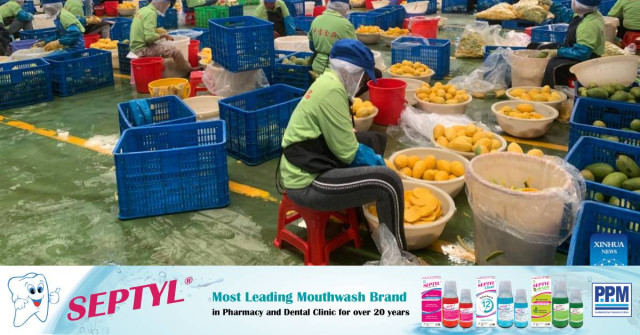Marine Ecosystems Under Threat: Expert

- By Meng Seavmey
- September 2, 2022 10:30 AM
PHNOM PENH – Cambodia’s coastal and marine ecosystems, with an economic value of $200 million to $600 million a year, face many challenges, a fisheries expert has warned.
The mangroves, seagrasses, coral reefs and fisheries resources face in particular a lack of waste and pollution management and inadequate awareness.
This was despite the implementation of marine protected areas and management, Lou Vanny, Cambodian coastal and marine fisheries specialist at the International Union for Conservation of Nature (IUCN), said.
The threats and challenges undermined coastal and marine ecosystem management, he said at the AVI-SDG dialogue on “Sustainable Ecosystem Management in Cambodia” coordinated online by the Asian Vision Institution on August 29.
“Coastal and marine areas also support a lot of work and contribute to building national economic growth, especially tourism, job creation, agriculture of marine fisheries, and marine grass exploration,” Vanny said.
Threats to marine ecosystems management
Threats driving changes to coastal and marine ecosystems management included habitat destruction and biodiversity resources loss, over-exploitation of resources, pollution, rapid coastal urban development, lack of strict law enforcement, climate change, as well as poverty and lack of alternative livelihood.
“There are some identified threats caused by different factors, including coastal encroachment for private ownership, lack of clear coastal land use zoning, destructive fishing methods, and economic land concessions,” he said.
“Illegal fishing and destructive fishing practices, such as using trawling and fine mesh nets, are caused by lack of regulations and law enforcement on fishing grounds, lack of awareness and education, and increasing populations.”
The major threats were pollution and marine litter caused by solid waste, sewage and oil spills.
These were driven by rapid and uncontrolled coastal development characterized by fast-tracked urban resettlement development, lack of waste and pollution management, lack of regulation and enforcement on pollution management, inadequate sewage disposal and treatment systems, and limited understanding of local people on proper waste management and handling.
Strategies to manage marine ecosystems
Vanny suggested that, because of the lack of integrated planning and zoning, maritime spatial planning (MSP) should be revisited and modified with sufficient capabilities developed to reflect the current situation that aims to complete, inform, and be integrated with coastal land use zoning for all four coastal provinces, including Kep, Kampot, Preah Sihanouk, and Koh Kong provinces.
Vanny said effective marine protected areas implementation was challenged by low capacity, lack of budgetary resources, and poor inter-agency coordination that needs to be addressed.
He recommended conservation and budget planning at the provincial department level should be strengthened and better integrated with MPA site-level management to reflect the needs and challenges of individual MPAs.
Secondly, he said budget allocation at MPA site level should be increased. It’s suggested that at least $1,000 per month per site be considered for direct support to improve the effectiveness. Similarly, expansion of staff including local rangers should be considered.
His third recommendation was boundary demarcation plus signboards.
Capacity-building at all levels should also focus on increasing officials and key stakeholders, especially local leaders who are knowledgeable about national law and the legal framework related to coastal and marine conservation and management.
“The focus should also be on the site-level capacity at marine protected areas for management planning, zoning, biodiversity assessments, community-based monitoring, and management evaluation,” he said.
“The M&E and reporting system should be strengthened, in particular to evaluate all coastal development proposals and to monitor coastal pollution more effectively, changes in coastal and marine biodiversity and other key indicators.”
Vanny said Cambodia should explore policies to require businesses along the coast to make financing contributions to the protection and conservation of coastal ecosystems, including sustainable livelihood.
Cambodia should also conduct studies to identify private companies that benefit from marine ecosystem services and develop voluntary payments for ecosystem services (PES) schemes and/or impact investment models, focused initially on MPAs.
“The work done by the government and relevant partners is not enough, but the people are also considered as the key actors,” he said.
“Therefore, public awareness and outreach should be raised to increase further understanding on key values of ecosystems and key issues.
“There should be more scientific research and surveys to provide data on biodiversity, economic values, and so on, provided by coastal and marine ecosystems.”
Coastal and marine ecosystems management
Ken Bopreang, director of the Department of Biodiversity, General Directorate of Policy and Strategy at Ministry of Environment, said Cambodia has been making progress to manage coastal and marine ecosystems, including implementing Goal 14 of Sustainable Development Goals. However, there were still challenges to be addressed and tackled.
“From 2016 to present, Cambodia has 73 protected areas and biodiversity corridors covering 7.2 million hectares. (41 percent of total land). There is a progress towards SDG 14 which aims to conserve and manage the use of oceans, seas, and marine resources for sustainable development,” Bopreang said.
Bopreang said the ministry continues to take actions to tackle issues by a series of measures including managing coastal and marine ecosystems by implementing sea pollution from land management plan.
The ministry also developed and implemented its Fisheries Strategic Framework 2010-2019 for fresh and marine fisheries resources management.
Bopreang cited key actions the ministry had taken, including studying and compiling data on potential coastal and marine resources in Preah Sihanouk and Koh Kong provinces, preparation of Koh Rong marine park management plan.
The ministry proposed short-term action including studying and compiling data on potential coastal and marine resources, and conducting a feasibility study for the establishment of new MPAs.
Long-term actions aim to identify, invent, monitor and enhance awareness of coastal and marine ecosystems, maintain ecosystems and coastal biodiversity protection and sustainability of water resources.
Challenges of marine ecosystems management
Bopreang said challenges include rapid economic development in the coastal provinces, especially Sihanoukville, increasing numbers of tourists, increase in transportation services by sea, and limitation of infrastructure for waste management and polluted chemical substances to prevent marine pollution.















